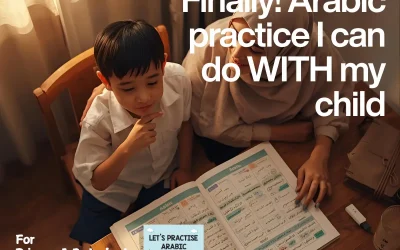Hey there, amazing parents! If you’ve got primary and secondary madrasah students learning Arabic at home, you know just how important it is for them to have a cozy and productive study space. The right environment can make a world of difference in their learning journey. Here are some friendly, practical tips to help you organize your child’s study space for maximum productivity, no matter your budget or space constraints.
Choose the Right Location
Pick a quiet and comfy spot in your home for your child’s study area. It should be free from distractions like the TV, loud noises, and busy foot traffic. Whether it’s a corner of a room, a dedicated study nook, or even a small section of the living room, make sure it’s somewhere your child can focus without interruptions.
If space is tight, think outside the box! A folding table or a section of the kitchen table dedicated to study time can work wonders. Just make it their special spot for learning.
Keep It Well-Lit
Good lighting is key to effective studying. Natural light is the best, so try to set up the study space near a window. If that’s not possible, grab a good-quality desk lamp. Poor lighting can strain your child’s eyes and make concentrating challenging.
You can find affordable desk lamps at thrift stores, garage sales, or discount stores. Even a simple clip-on lamp can brighten up the study space beautifully.
Comfortable Seating
It is essential to have a supportive chair that promotes good posture. Your child will spend a lot of time studying, so a good chair is a great investment. If an ergonomic chair isn’t in the budget, use a firm pillow to support your child’s back or a sturdy kitchen chair with some added cushions.
Thrift stores or online marketplaces (Shopee, Lazada, Amazon, etc.) often have great deals on chairs. With a little creativity, you can turn a basic chair into a cozy study seat.
Organized Supplies
Keep all necessary supplies within arm’s reach. This includes textbooks, notebooks, pens, pencils, highlighters, and other study materials. Desk organizers, shelves, and storage bins help keep everything tidy. An organized space means your child can focus more on studying instead of hunting for materials.
On a budget? Recycle containers like jars, shoeboxes, or plastic bins to organize supplies. Let your child decorate them for a personal touch.
Make the Space Inviting
Let your child personalize their study area, even if space is limited. Add their favorite color, a few motivational posters, or a small plant. A space that reflects their personality can make them feel more comfortable and motivated to study.
In tight living conditions, use wall space effectively. Hanging organizers, wall-mounted shelves, or a corkboard for motivational quotes and artwork can maximize space without cluttering the floor.
Minimize Digital Distractions
When your child is using a computer or tablet for studying, it’s essential to minimize distractions from social media, games, and other online activities. You can achieve this by using specific apps or settings that restrict access to non-study-related websites during their study time. Additionally, it’s beneficial to encourage them to take short breaks to check their devices rather than allowing constant interruptions, which can disrupt their concentration.
It’s also advisable to establish clear rules regarding screen time and consider implementing parental controls to effectively manage and monitor your child’s online activities during their designated study hours. These measures promote a focused study environment and ensure that your child stays on task and avoids unnecessary distractions.
Set a Routine
Establish a consistent study routine. Having a set time each day for studying helps your child develop good habits and improve productivity. Make sure this routine includes short breaks to prevent burnout and keep their mind fresh.
For single mothers or busy parents, involving older siblings or other family members to help maintain this routine can be beneficial. Consistency is key, and having a reliable schedule makes a big difference.
Encourage Cleanliness
A clean and organized study space is essential for a productive learning environment. It’s important to encourage your child to develop the habit of tidying up their study area at the end of each study session. By doing so, they can maintain an organized and clutter-free environment, making it easier to dive into their work the next time they sit down to study.
Even in compact or small study areas, implementing a quick five-minute tidy-up routine at the end of each day can work wonders. This simple practice ensures that the study space remains fresh, inviting, and conducive to learning, setting the stage for a successful and focused study session.
Use Learning Aids
Incorporate learning aids like flashcards, educational posters, and Arabic language apps. These tools make learning more interactive and enjoyable. Having them readily available in the study area encourages your child to use them often.
Many educational resources are available for free online or can be created at home using simple materials. Flashcards can be made from index cards, and posters can be drawn or printed at home.
Stay Involved
Stay involved in your child’s learning process. Check-in regularly to see how they’re progressing, offer help when needed, and provide encouragement. Your interest and support can significantly boost their motivation and confidence.
For busy parents, even short, regular check-ins can make a big difference. A quick conversation about their day or reviewing their progress shows your child that you’re invested in their success.
Creating an effective study space for your child doesn’t have to be complicated or expensive. With these simple and affordable tips, you can support your child in establishing an effective study schedule and enhance the enjoyment and success of their Arabic language learning journey. Remember, the key is to create a space that’s organized, comfortable, and free from distractions. Your support and involvement will also play a crucial role in their academic success.
So, let’s roll up our sleeves, get creative, and make a fantastic study space for our little learners. Happy studying, and may your child’s educational journey be filled with joy and success!





